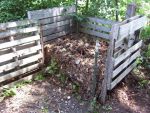
|
||
|
|
|
|
| Forgot Password | ||
Composting
Posted by MariaBBB |
Added on : 8 days ago |
Viewed 1599 times
| 0 Comments | This article is also in bushel basket
and bushel basket
Composted manure has many distinct advantages over ripe smelling manure. Manure's high urine content can cause plants to burn, and flies and other insects lay eggs in it. Composting takes time, so use a bin to compost efficiently. By following a basic procedure you can compost manure for a constant supply once you get the wheelbarrow rolling.
Prepare: a compost bin, stall wastes (hay, straw, etc.), tined fork, wheelbarrow, PVC thatís 4 inch by 2 inch diameter and 5 feet long (1/4 inch holes spaced evenly), manure, flat shovel, and tarp or thick plastic.
 The first step is to construct the compost bin so the final foot print dimensions are 5 to 7 feet square with a height of 4 feet. The boards should be equally spaced on the sides so each row alternates with an empty space. This allows plenty of cross air ventilation. Build two bins for 1 to 5 animals. Add a third bin for daily waste from the household.
The first step is to construct the compost bin so the final foot print dimensions are 5 to 7 feet square with a height of 4 feet. The boards should be equally spaced on the sides so each row alternates with an empty space. This allows plenty of cross air ventilation. Build two bins for 1 to 5 animals. Add a third bin for daily waste from the household.
Secondly, load the first compost pile in one of the bins with 10 to 12 inches of stall waste. Haul waste from the area in the wheelbarrow after loading with the tined fork.
For the third step, lay two of the 2-inch diameter PVC pipes that are 5 foot long near the center of the pile. They should have 1/4-inch diameter drilled holes evenly spaced every 2 to 3 inches running the length of the pipe. These pipes will permit fresh air to flow into the pile.
The fourth step is to add a layer of the fresh manure on top of the stall waste layer. Use the flat shovel to evenly distribute the manure to a depth of 8 to 10 inches.
Fifthly, add another layer of stall waste to the same depth as in the second step. Place one more set of pipes in the pile. Add a layer of manure onto this. Continue the layering until you reach the top of the bin. Do not add any more pipes in the top layers.
For the sixth step, cover the pile with a tarp or thick plastic. There will be adequate moisture for the pile to begin its composting. Rain will cause to pile to cool down. Heat will begin to generate from the microbial action in two to four weeks. The pile will be finished composting in two to four months depending on weather conditions and the content of manure.
Lastly, continue the manure composting in the second bin. Add the stall waste and manure on a daily basis or as the animals produce manure.
If possible, turn the outside areas of the composting pile back into the heated center. By laying the PVC pipes close to the center of the pile, they should not have to be disturbed. Composted manure can be added directly to the garden.
Composted manure is a primary source of soil fertility for organic farmers. It offers a natural means to cycle plant nutrients. As such, animal manure forms an important part of organic soil fertility programs.
 The first step is to construct the compost bin so the final foot print dimensions are 5 to 7 feet square with a height of 4 feet. The boards should be equally spaced on the sides so each row alternates with an empty space. This allows plenty of cross air ventilation. Build two bins for 1 to 5 animals. Add a third bin for daily waste from the household.
The first step is to construct the compost bin so the final foot print dimensions are 5 to 7 feet square with a height of 4 feet. The boards should be equally spaced on the sides so each row alternates with an empty space. This allows plenty of cross air ventilation. Build two bins for 1 to 5 animals. Add a third bin for daily waste from the household.


Be the first one to comment on this article